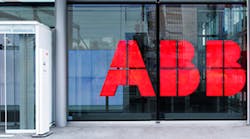ABB Ltd. is doubling down on its effort to prove Swedish activist shareholder Cevian Capital AB was wrong.
After defying pressure from the investor to spin off its power grids division, the Swiss industrial company is now refining a plan to make it more profitable. Higher-margin services already make up around 15% of sales, and this proportion will be raised to about a third in the coming years, according to division head Claudio Facchin. Growth will come through bolt-on acquisitions and internal development.
“If you look at the way we should shape our portfolio, we definitely need to focus more on the whole digital and software space,” he said in an interview at the company’s headquarters in Oerlikon. The maker of transformers and high-voltage equipment for utilities will expand its offerings in more profitable services like upgrading and maintaining equipment.
ABB is reshaping power grids in a bid to show the division is better off as part of the bigger company. The engineering firm’s second-largest investor, Cevian, called for a breakup of the nearly three-decade-old combination created from a merger of Sweden’s ASEA and Switzerland’s Brown, Boveri & Cie. After putting the underperforming and largest unit under review the previous year, CEO Ulrich Spiesshofer said Oct. 4 power grids would be kept within the fold. Cevian co-founder Christer Gardell called the decision “unfortunate.”
“We did comprehensive work and we really took the time to understand from a market standpoint what we need to do with our portfolio, business models, technology and operations,” Facchin said in the interview.
A spokesman for Cevian declined to comment.
ABB shares fell 0.5 percent to 21.12 Swiss francs ($20.94) by 4:07 p.m. in Zurich. The stock is up 22 percent this year.
Greater reliance on services is partly behind ABB’s plan to boost margins at the power grid division, according to Facchin. ABB in October raised the January, 2018 operational profit margin target to a range of 10% to 14% from 8% to 12% previously and said the “transformation” of the unit would unlock more value than a sale, initial public offering, spinoff or joint venture. The margin was 9.5% in the third quarter, lagging that of all other divisions at ABB including the 12.6% for the group.
Power grids will also benefit from a company-wide drive to digitalize products, Facchin said.
“Digitalization, grid automation and software are definitely priorities for us going forward,” said the executive. “In terms of hardware, we need to continue to invest in technological content.”
With a focus on digitalization, ABB will join the ranks of industrial firms including General Electric Co. and Siemens AG that expect growth to come from selling software and other applications to customers wanting to automate equipment. The U.S. and German engineering companies have been on a buying spree this year, acquiring U.S.-based software companies, with GE saying it aims to be one of the top 10 software companies by 2020.
Industrial companies are increasingly shifting their use of software from control applications toward design, analytics and services, analysts at Citi wrote in a note to clients. Software drives profits through low fixed overheads, which means higher gross margins, leading to better operating margins, according to Bloomberg Intelligence analyst Jawahar Hingorani.
For its part, Facchin said ABB will have an advantage over competitors because the Swiss firm can use its position as the the world’s largest maker of power grids to offer services to existing customers of its installed base: “We need to transform the way we deal with customers and aim to have the best in consulting capability,” he said. “We want to leverage the software capability.”
ABB’s power grids unit has long been under the spotlight even before Cevian began building its stake, which stands at about 6%. When Spiesshofer took the helm in 2013, he named Facchin to head the division and pledged a return to profitability after expensive delays at offshore wind energy projects weighed down earnings.
By Alice Baghdjian



